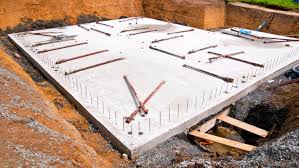Monolithic slab foundations are a popular choice in construction due to their simplicity, cost-effectiveness, and suitability for certain types of soil. This article aims to provide a comprehensive guide to monolithic slab foundations, exploring their characteristics, advantages, disadvantages, and key considerations in construction.
Definition and Construction:
A monolithic slab foundation is a single, continuous concrete slab that serves as both the foundation and the floor of a building. It is poured all at once, with no separate footing. This seamless design simplifies the construction process and eliminates the need for complex forms and multiple pours, making it a cost-effective option.
Advantages of Monolithic Slab Foundations:
- Cost-Effective: One of the primary advantages of monolithic slab foundations is their affordability. The simplicity of the construction process reduces labor and material costs, making it an attractive option for budget-conscious builders.
- Speed of Construction: Monolithic slabs can be poured quickly, accelerating the overall construction timeline. This can be especially beneficial in projects with tight deadlines.
- Minimal Site Preparation: Unlike other foundation types that may require extensive excavation and grading, monolithic slabs often require minimal site preparation. This can be advantageous in areas with stable soil conditions.
- Energy Efficiency: Monolithic slabs provide a continuous thermal mass, helping to regulate indoor temperatures and improve energy efficiency. This can result in cost savings over the life of the building.
Considerations and Disadvantages:
While monolithic slabs offer several advantages, they may not be suitable for every project. Consider the following factors:
- Soil Conditions: Monolithic slabs are best suited for stable soil conditions. Expansive or poorly compacted soils may lead to foundation issues, such as settling or cracking.
- Limited Design Flexibility: The seamless nature of monolithic slabs can limit design options. For buildings with intricate floor plans or multiple levels, alternative foundation types may be more suitable.
- Insulation Challenges: Insulating a monolithic slab can be more challenging compared to foundations with crawl spaces or basements. Proper insulation is crucial for energy efficiency and comfort.
- Repair Difficulty: If issues arise with a monolithic slab foundation, repairs can be more challenging and expensive than with other foundation types. Accessing the entire foundation may require extensive excavation.
Conclusion:
Monolithic slab foundations are a practical and cost-effective choice for certain construction projects. Understanding their advantages, disadvantages, and key considerations is essential for builders, architects, and homeowners alike. Before opting for a monolithic slab foundation, it is crucial to assess soil conditions, project requirements, and long-term implications. While this foundation type may not be suitable for every scenario, its simplicity and affordability make it a valuable option in the right context.

